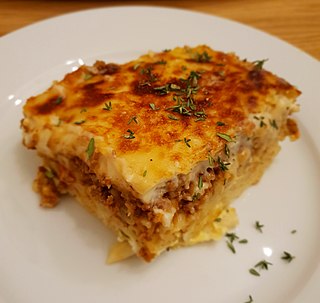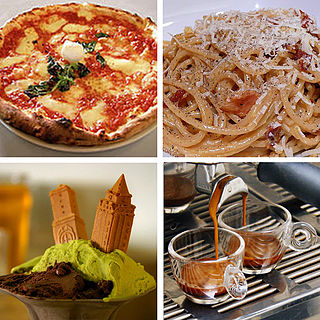
Gnocchi are a varied family of dumplings in Italian cuisine. They are made of small lumps of dough, such as those composed of a simple combination of wheat flour, potato, egg, and salt. Variations of the dish supplement the simple recipe with flavour additives, such as semolina flour, cheese, breadcrumbs, cornmeal or similar ingredients, and possibly including herbs, vegetables, and other ingredients. Base ingredients may be substituted with alternatives such as sweet potatoes for potatoes or rice flour for wheat flour. Such variations are often considered to be non-traditional.

Lasagna, also known as lasagne, is a type of pasta, possibly one of the oldest types, made in very wide, flat sheets. The same-named Italian dish is made of stacked layers of lasagna alternating with fillings such as ragù, béchamel sauce, vegetables, cheeses, and seasonings and spices. The dish may be topped with grated cheese, which becomes melted during baking. Typically cooked pasta is assembled with the other ingredients and then baked in an oven. The resulting baked pasta is cut into single-serving square or rectangular portions.

Carbonara is a pasta dish made with fatty cured pork, eggs, hard cheese, salt, and black pepper. It is typical of the Lazio region of Italy. The dish took its modern form and name in the middle of the 20th century.

Calzone is an Italian oven-baked turnover, made with leavened dough. It originated in Naples in the 18th century. A typical calzone is made from salted bread dough, baked in an oven and stuffed with salami, ham or vegetables, mozzarella, ricotta and Parmesan or pecorino cheese, as well as an egg. Different regional variations in or on a calzone can often include other ingredients that are normally associated with pizza toppings. The term usually applies to an oven-baked turnover rather than a fried pastry, though calzoni and panzerotti are often mistaken for each other.

Pastitsio is a Greek baked pasta dish with ground meat and béchamel sauce, with variations of the dish found in other countries of the Mediterranean Sea.

In Italian cuisine, ragù is a meat sauce that is commonly served with pasta. An Italian gastronomic society, Accademia Italiana della Cucina, documented several ragù recipes. The recipes' common characteristics are the presence of meat and the fact that all are sauces for pasta. The most typical is ragù alla bolognese. Other types are ragù alla napoletana, ragù alla barese, ragù alla veneta, and so on.

Parmigiana, also called parmigiana di melanzane, melanzane alla parmigiana or, in the United States, eggplant parmesan, is an Italian dish made with fried, sliced eggplant layered with cheese and tomato sauce, then baked. The origin of the dish is claimed by the Southern regions of Calabria, Campania, Apulia and Sicily. Other variations found outside Italy may include chicken, veal, or another type of meat cutlet or vegetable filling.

Cacciatore refers to a meal prepared with onions, herbs, usually tomatoes, often peppers, and sometimes wine. It is typical of the Italian cuisine.

Italian cuisine is a Mediterranean cuisine consisting of the ingredients, recipes, and cooking techniques developed in Italy since Roman times and later spread around the world together with waves of Italian diaspora. Significant changes occurred with the colonization of the Americas and the introduction of potatoes, tomatoes, capsicums, maize, and sugar beet—the latter introduced in quantity in the 18th century. It is one of the best-known and most appreciated gastronomies worldwide.

A crostata is an Italian baked tart or pie. The earliest known use of crostata in its modern sense can be traced to the cookbooks Libro de Arte Coquinaria by Martino da Como, published c. 1465, and Cuoco napolitano, published in the late 15th century, containing a recipe titled Crostata de Caso, Pane, etc..

Spaghetti and meatballs is an Italian-American pasta dish consisting of spaghetti, tomato sauce, and meatballs.

Cotoletta is an Italian form of breaded cutlet made from veal. The dish originated in France as the côtelette de veau frite, and was created by the chef Joseph Menon in 1735. Côtelette means 'little rib' in French, referring to the rib that remains attached to the meat during and after cooking.

Panzerotto, also known as panzarotto, is a savory turnover, originating in the cuisine of central and southern Italy, which resembles a small calzone, both in shape and dough used for its preparation. The term usually applies to a fried turnover rather than an oven-baked pastry, though calzoni and panzerotti are often mistaken for each other.

Chicken parmesan or chicken parmigiana is a dish that consists of breaded chicken breast covered in tomato sauce and mozzarella, Parmesan, or provolone. Ham or bacon is sometimes added.

Neapolitan cuisine has ancient historical roots that date back to the Greco-Roman period, which was enriched over the centuries by the influence of the different cultures that controlled Naples and its kingdoms, such as that of Aragon and France.

Tagliolini is a type of ribbon pasta, long like spaghetti, roughly 2–3 mm wide, similar to tagliatelle, but thin like capellini. It is a traditional recipe in the Molise and Piedmont regions of Italy. In Piedmont it is called tajarin and made of egg dough. The dough also contains semolina, flour and salt. It is typically served with butter and truffles or sugo d'arrosto, a sauce made from the drippings of roast meat. Tagliolini have a short cooking time, especially when made from fresh dough, and work best with light sauces, fish, delicacies or soups.

Bolognese sauce, known in Italian as ragù alla bolognese or ragù bolognese, is a meat-based sauce in Italian cuisine, typical of the city of Bologna. It is customarily used to dress tagliatelle al ragù and to prepare lasagne alla bolognese.

Veal Milanese, known in Italian as cotoletta alla milanese, is a popular variety of cotoletta found in the city of Milan. According to some sources it has a French origin and was brought to Milan during the Napoleonic Wars, where it was first known as cotoletta rivoluzione francese. It is traditionally prepared with a veal rib chop or sirloin bone-in and made into a breaded cutlet, fried in butter. Due to its shape, it is often called oreggia d'elefant in Milanese or orecchia d'elefante in Italian, meaning 'elephant's ear'.

The cuisine of Basilicata, or Lucanian cuisine, is the cuisine of the Basilicata region of Italy. It is mainly based on the use of pork and sheep meat, legumes, cereals and vegetables, with the addition of aromas such as hot peppers, powdered raw peppers and horseradish. The local gastronomy is, for historical-cultural reasons, typically peasant, based on simple recipes and on the culture of reuse, in particular of meat and bread.

















